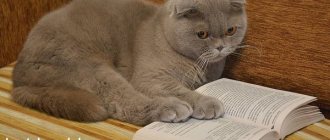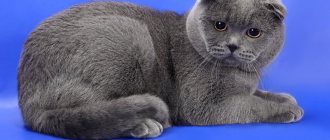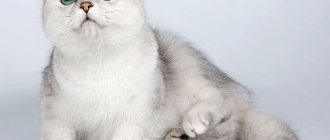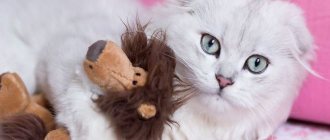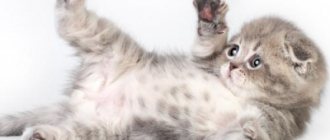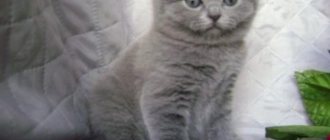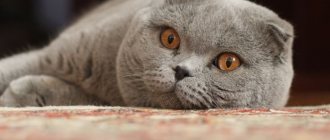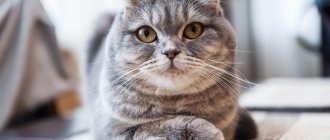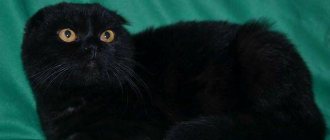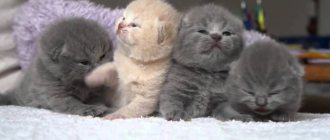Cats with four ears
Nature is a tireless dreamer. Thanks to her passion for experimentation, people enjoy communicating with bare-skinned cats, curly and short-tailed, fold-eared and short-legged. But the fabulous-looking cat with four ears is simply shocking! I just want to ask: “What planet are you from, amazing creature?”
Fantastic cats with four ears have been mentioned in various sources for more than seventy years. The most famous representative of the “alien” species is Yoda the cat from Downers Grove, Illinois. It is so popular that its owners have collected an impressive collection of newspapers and magazines with publications about their favorite.
Yoda was born in the litter of a yard cat who worked as a rat catcher in a Chicago pub. When the cat brought the kittens, the pub staff didn't even notice that one of the babies was different from its brothers and sisters. The babies were put in a box and placed near the counter, hoping that at least some of the kittens could be accommodated.
Ted and Valerie recently lost their pet, who had lived with them for almost twenty years. They never thought about getting a new pet. But the tiny cat with four ears immediately won their hearts and insisted on moving into their home, climbing into Ted's arms and instantly falling asleep. At first, Valerie was worried about Yoda having an extra pair of ears, but the veterinarians assured her that the kitten was healthy. One of the doctors even turned to colleagues for help and began collecting information about this anomaly. It turned out that an adult cat with 4 ears lives in Germany, absolutely happy and full-fledged. The veterinarians' predictions came true: Yoda grew up to be a healthy and normal cat, and the extra ears did not bother him in any way.
Four-legged cats that arrived from a distant galaxy honored Russia with their presence. On the territory of one of the car service centers in Vladivostok, a kitten named Luntik (in honor of the hero of the children's cartoon series) was born in the litter of a yard murka. What distinguishes Luntik from his mother and littermates is an extra pair of tiny ears located in front of his regular ears. The baby is absolutely healthy, playful and curious.
But cats with four ears are not the most wonderful creatures. In Voronezh there lives a cat that has five ears, two on the left and three on the right! Vladimir, passing by the dining room, noticed something strange in the ears of a stray cat. From a distance it seemed to him that something was stuck there, but upon closer examination he realized that the yard muk was a carrier of a unique gene.
Luntya is not just a pet. She settled in the house of an associate professor of the Department of Anatomy, General Biology and Histology of the Faculty of Veterinary Medicine, and helps her owner research a genetic mutation. Vladimir Obryvkov does not keep Luntya in the laboratory and does not conduct terrible experiments on her - the cat lives in his apartment, a happy and well-fed life.
Vladimir Obryvkov says that a four-eared cat, like a five-eared one, is a carrier of a recessive gene, which manifests itself only if the litter is born from two homozygous or heterozygous individuals. That is, in order for a kitten with unusual ears to be born in a litter, both parents must carry this gene in explicit or hidden form. According to Vladimir, cats with extra ears are physically healthy and healthy; the extra ears are not fully formed, do not have ear canals and do not function in any way.
Another Luntik lives in Novocherkassk, but unlike Luntik from Voronezh, he has three pairs of ears! A cat with 4 ears lives in Rostov-on-Don. Some zoologists consider this mutation to be the result of a deteriorating environmental situation. Their opponents argue that all cat mutations - bare skin, floppy ears, long or curly hair, short legs or a stubby tail - are an ordinary “program glitch” that has nothing to do with external factors.
Small ears are the key to great happiness
Scottish cats are becoming increasingly popular among cat lovers, and for very pragmatic reasons. Exotic cats are most often artificially bred, which means they are susceptible to various diseases and require special care and nutrition. In the modern rhythm of a huge metropolis, it is difficult to provide your pet with proper care and attention, so people choose animals as pets that optimally maintain a balance between beauty and unpretentiousness.
Scots are omnivores, and thanks to their soft mouton coat, they tolerate the Russian climate well - when it is hot and drafty in summer, and in winter the air is very dry due to central heating. There are widespread rumors that due to the specific structure of the ears, these cats often have hearing problems and other diseases. But veterinarians and breeders say this is a myth. Scottish cats hear perfectly and do not suffer from any deviations, except for funny curved ears.
In 1961, farmer William Ross came across a white kitten with funny ears on his estate. Fortunately, William was a true connoisseur and lover of animals, he registered the grown-up cat Susie with the GCCF of Great Britain (the register of cat breeds of the United Kingdom) and began breeding fold-eared kittens. Later, professional geneticists took over his work.
By the way, the ears of the first cat, Suzy, were bent just a little with a strong tilt forward, but now show-class cats have ears that fit tightly, and sometimes are not noticeable at all, this effect was achieved as a result of complex selection.
Unfortunately, later the BCF (British Cat Fancy) thought that breeding animals artificially was not entirely humane, and Scottish Folds can have various diseases, and the breed was excluded from the list of registered ones. Thus, this breed is not recognized in England and Europe, but is nevertheless popular throughout the world.
Scots are often confused with British cats, despite the fact that for an experienced specialist they are also not similar, as for us Persian and Sphynx cats are. It’s just that during the selection process, folds were crossed with the British and exotics in order to achieve more characteristic characteristics of the breed, as well as stable color and fixation of the ears.
Today only fold-eared kittens are allowed to exhibit, but except for their ears, they do not differ from their relatives - the same fur, the same eyes, the same character. But straights, despite the doom of their show career, are very important for breeding. You cannot cross two folds, because this will lead to congenital skeletal defects in the offspring. The ideal husband and wife are straight and fold.
Its peaceful disposition makes this breed a true family pet. Forums of breeders and owners are full of messages about wonderful love and friendship between small children and fold-eared cats. A real fluffy pillow and a purring hot water bottle - these are the epithets used to describe the Scottish.
But your pet will not differ in intelligence. No, he can easily learn how to open the refrigerator with his paw or what time you come home. But your pet is unlikely to be a hunter, a guard, or a threat to the neighbors’ cats.
If you decide to breed this breed, then you will give birth together with the Fold. So if your pet is pregnant, read in advance how to deliver a cat or keep the veterinary emergency phone number in a visible place. It doesn’t happen once in a while, but if you’re forewarned, you’re forearmed!
Despite such minor disadvantages, Scottish Fold cats are optimally adapted to living with people. Such a cat respects and values both its personal space and its owners. And without difficulty he will become the warm and charming pride of the house and a friend of each family member.
Source
Features, pros and cons
There are a great many different breeds of cats, and each of them has its own individual characteristics that distinguish them from other subspecies. This non-standard structure of the animal skull is otherwise called brachycephalic. This is not the design of nature, but the work of man - cats and cats with similar features were bred artificially. In fact, this design of the animal’s muzzle is not normal.
Simply put, it is a kind of pathology. But today animals with such a structure are not treated as defective. On the contrary, charming owners of flattened faces are incredibly popular and loved by many people. Representatives of several well-known breeds have a flattened muzzle.
It is worth understanding what the main pros and cons of cats with flat faces are. Let's start with the good - let's look at the positive aspects.
- The main advantage that is noticed about such pets is their original and very interesting appearance. Even in our time, when it is difficult to surprise anyone with cats of various breeds, animals with a brachycephalic skull attract a lot of attention.
- The jaws of such pets are stronger than those of representatives of breeds with a classic muzzle structure.
- The lion's share of cats with a similar structure have a very affectionate, friendly character. They are sociable, unobtrusive and behave absolutely calmly in everyday life. These are the qualities that many people look for in pets.
Now let’s look at what are the shortcomings of these unusual pets.
- For such cats, it is necessary to select not ordinary, but special dishes from which they can drink and eat comfortably, without unnecessary interference.
- The non-standard shape of the skull of these pets becomes an inevitable cause of noisy sleep, snoring and snorting. Some people really don’t like these features of animal behavior and cause irritation.
- Cats with a flattened face are distinguished by having shortened tear ducts and a non-specific nose shape. These factors lead to the fact that such pets, experiencing severe stress, may suffer from severe discharge. Similar problems can arise if the cat has been in the cold.
- Some species of animals with a similar skull structure cannot eat on their own, regardless of the selected food and its consistency. Such animals should be treated like small children - spoon-fed. Not every person agrees to this, so you need to think several times whether you are ready to acquire such a fluffy fidget.
- The peculiarities of thermoregulation in these animals are such that they cannot tolerate the influence of low temperatures.
- Due to the nasal discharge described above, such cats very often suffer from various types of infectious diseases. In addition, they are prone to allergic reactions.
From all of the above, we can conclude that such cats have more disadvantages than advantages. Although, many of the disadvantages of such animals are better called their features.
Causes of irregularly shaped ears in cats
The cause of abnormal ear structure is a mutation gene, and it is different for each breed. For example:
- Scottish Fold gene is a dominant lop ear gene with partial penetrance. Representatives of pets with this mutation have ears that “look” forward. Moreover, the degree of fit of the ears varies. The gene for fold-eared breeds is also associated with limb defects: in parallel with “wrong” ears, changes occur in the cat’s skeleton. Because of this, breeders stopped crossing two individuals of Scottish Folds with each other, thereby eliminating animal health problems.
- American Curl gene. With this mutation, the cat’s ear begins to “curl” towards the upper tip. The ear can be turned up to 180 degrees. This gene does not have a negative effect on the development of the cat and its health.
- Round ears. As a result of the predominance of the mutating gene, the animal has not the traditional triangular shape of the ears, but a round one. This “defect” was first discovered in pets in Italy, and later in America.
Peculiarities
What is the difference between big-eared cats and all the others? As strange as it may sound, it has the ability to cool quickly. After all, cats with big ears are natives of warm countries. They have very thin skin on their ears, and underneath there are a large number of blood vessels. A light breeze is enough to cool them down. The higher the ambient temperature, the faster the blood circulation, which means that a large amount of blood will flow through the ear capillaries, cooling them.
Large-eared purebred cats have plenty of fans, because they really look very unusual. However, it would be a misconception to believe that the hearing of such breeds is better than that of other cats. No, all breeds hear equally well. Even the most lazy and aloof ones, half asleep, twitch their ears, monitoring every sound that comes through. These animals have excellent hearing - they hear everything that happens within a radius of 500 m around, even the squeak of a mouse. At the same time, neither walls, nor layers of earth, etc. are an obstacle to them.
Devon Rex and Gherkin Rex
The Devon Rex breed, bred in England, quickly conquered the world. The cats have a nice short, slightly curled coat, with huge ears sometimes topped with tufts.
Expert opinion
Slanimsky Alexey Georgievich
Veterinarian of the highest qualification category. Has extensive experience in diagnosing and treating diseases in animals.
You are unlikely to find a more loyal cat than the Devon Rex. Cats of this breed are very smart, easily learn commands, and cases have been recorded of Devon Rex protecting their owners.
In their behavior, Devons and Cornishes are the epitome of aristocracy: they do not steal food from the table, they are instantly litter-trained, they are as clean as possible, they are not vengeful and do not bite. They can be easily walked on a leash and experience virtually no stress when traveling or moving.
Purchasing kittens
Kittens should be purchased only from trusted nurseries or from reputable breeders.
A list of some nurseries engaged in breeding breeds of kittens with large ears:
- LovEI, Moscow (Cornish Rex).
- In Plush Paradise, Moscow (Devon Rex).
- Valli, Chelyabinsk (oriental, Maine Coon).
- La Suerte, Volgograd (Canadian Sphynx, Devon Rex).
- Ocharovashka, Moscow (Abyssinian, oriental).
- AMAGITSUNE*RU, Rostov-on-Don (Somalia).
- NIKOLAEVS PRIDE*RU, St. Petersburg (Somali, snow shoe).
- ALF, Samara (Siamese, oriental).
It is not recommended to purchase kittens without documents in markets and from unknown breeders, since an unscrupulous seller can sell a mixed breed or a sick animal for a high price.
How to recognize a cat's breed by its special coat
The structure of the coat varies greatly among different breeds . Cats are mostly divided into short-haired and long-haired.
Long, thick and straight coat with dense undercoat:
- Angoras;
- Burmese;
- British and Scottish longhair;
- Himalayan;
- Maine Coon;
- Neva Masquerade;
- Norwegian forest;
- Persian;
- ragdoll;
- Siberian;
- Somalia;
- Turkish van.
The Bohemian Rex, Selkirk Rex, Laperm have long and wavy fur
Short with tight curls in the Cornish Rex, Devon Rex and German Rex.
a coarse and curly coat .
Bald breeds:
Reference. Rex cats have pleasant and soft fur, reminiscent of astrakhan fur.
Rare and non-standard cat breeds
Poodlecat - curly beauty
Both varieties of poodle cats - with erect and hanging ears - deserve attention in this article. However, breeders strongly recommend breeding representatives with erect ears to avoid skeletal problems. Poodlecats stand out not only for their large ears, but also for their unusually curly coat that does not require special care. They have a very kind and affectionate character and get along well with adults, children and other pets. They do not tolerate loneliness well.
Havana cat
One of the oldest specially bred cat breeds almost disappeared completely during the Second World War, but in the 50s of the last century they began to be specially bred in Britain, and then registered in 1958. Havana cats will spend all their time with you or other pets; they are one of the most sociable breeds. And therefore, from loneliness, they easily become depressed and get sick. They are distinguished by their intelligence and intelligence, are easy to educate and train, and will never use their claws and teeth without a good reason.
Toyger - domestic mini-tiger
Their character differs little from ordinary cats; they are docile and unobtrusive.
Toygers are big fans of sharpening their claws, so it is important to teach the kitten to do this with a scratching post.
Absolutely all individuals of this cat breed are controlled by the parent nursery of Judy Sugden and selection to improve this breed is currently ongoing.
How to recognize a cat's breed by external differences
Studying the appearance features will help determine the cat's breed .
The shape of the ears is a striking distinctive feature indicating belonging to a particular breed.:
- forward-curved ears are characteristic of the Scottish Fold and Highland Fold;
- turned back - only in the American Curl;
- small, low-set, close to the head - in the Highland Fold;
- medium-sized ears, devoid of vegetation with drooping tips - in the Ukrainian Levkoy;
- large, wide at the base, open, with smoothly curving tips - in the elf;
- triangular, pointed, with tassels at the tips - in the Maine Coon;
- hanging ears covered with curls of hair - the poodlecat;
- disproportionately large in relation to the head - in Abyssinians and Orientals.
Short tail
A short tail is a congenital trait that defines the breed:
- American and Kurilian bobtail;
- pixie bob;
- toy bob;
- Kymrik.
Toy Bob
Tailless breeds - Japanese Bobtail and Manx cat.
Reference. Cats of the eastern group of breeds have long and thin tails.
Little paws
In nature, short-legged cats are rare.
All breeds with short limbs were bred artificially:
Rules for caring for black fur
It is believed that blackies need special care. This is partly true, since the black color easily fades in the sun, forming reddish tan marks. Therefore, your pet should not be allowed to stay in direct sunlight for too long.
A prudent owner will take care of the animal’s diet, including meat, eggs, cat grass and various dietary supplements.
Otherwise, the following rules of coat care must be observed, taking into account the characteristics of each breed:
- the thick undercoat of Manx cats requires careful combing; after completing the procedure, the cat’s fur can be smoothed with a comb; these animals should be bathed no more than twice a year using special shampoos and conditioners that enhance shine;
- the fluffy Maine Coon, short-haired Curl and Bombay need to be brushed with a brush-comb at least once a week;
- long-haired Persians and Siberians require especially careful care - cats should be combed daily, first with a wide-tooth comb, then worked through the fur with a slicker brush, and at the end of the procedure, with a fine-toothed comb; animals can be washed up to four times a year; after water treatments, the wool should be treated with a special product to make combing easier;
- After brushing, a curly Devon Rex must be stroked with wet hands: then the curly hairs will form neat waves by themselves.
There are no great difficulties in care. If the owner sincerely loves his pet, he will easily find time to select a diet, comb the fur, communicate and play. Well, your furry pet will reciprocate 100% and will delight you not only with its playful mood, but also with its luxurious appearance.
See the characteristics of Bombay black cats in the video below.
Care and maintenance
Orientals are cats that do not particularly need any super complex care. All they need:
- Periodically clean your ears, which work like a real dust collector;
- Trim claws;
- Bath once every 6 months;
- Clean the skin of short-haired dogs with a rubber glove or brush, and of long-haired dogs with a special comb (not a slicker brush).
They are also unpretentious in content. It is necessary to provide a sun lounger in a secluded corner without drafts, as well as a scratching post so that the furniture remains intact. If it is a multi-level playground, it will be even better. If not, you need to provide the cat with a sufficient number of different toys and spend enough time playing with it.
You need to feed balanced food in accordance with the age and weight of the animal, as there is a risk of obesity. Fatty meats and fish should be avoided. The water should be changed regularly.
Oriental cats are oriental animals, and therefore are picky about cleanliness. Therefore, owners should clean trays with enviable regularity, otherwise the animal will look for other “cleaner latrines.” The same applies to bowls - if they are poorly washed or there is old food in them, the animal may even refuse to eat.
Other small breeds
There are other types of cats, differing in their miniature dimensions.
American Curl
This small cat weighs no more than 4.5 kg. He has a remarkable appearance and a playful, good-natured disposition. All American Curl kittens are born with straight ears, but after a few days they begin to curl back.
Devon Rex
This small cat has a graceful physique and a memorable appearance. The Devon Rex is easy to recognize by its large, expressive eyes, huge splayed ears and short, curled mustache.
As an adult, he weighs no more than 4.5 kg and can compete for the title of smallest cat.
Balinese cat
Representatives of the breed have slender, graceful bodies, shiny coats and fluffy tails. Graceful little cats weigh no more than 4 kg and look like Siamese, only with long hair.
Abyssinian cat
Thoroughbred Abyssinians are distinguished by their active temperament and graceful physique. These narcissistic, small, graceful cats weigh no more than 4.5 kg. And their toned bodies are covered with a luxurious shiny fur coat of wild, fawn, red or blue color.
How to determine cat breed by size
Pedigree cats are divided into 2 groups based on their body type.:
- Animals with a large, rounded head , a flattened nose and a stocky body. This is the body structure of Persians and exotics.
- Animals with a wedge-shaped head , an elongated and oblong muzzle, a long graceful body and limbs. Angora, Siamese, Balinese, longhair and oriental shorthair cats fit these characteristics.
As for the weight of purebred cats, it varies from 2 to 20 kg . The body length is 40-80 cm.
Big cats
- Ashera;
- British;
- Egyptian Mau;
- Kurilian and American bobtails;
- Maine Coon;
- Norwegian Forest Cat;
- pixie bob;
- ragamuffin;
- ragdoll;
- Siberian;
- Turkish van;
- chausie;
- chito;
- Chartreuse.
Asherah
Little cats
- bambino;
- Dwelf;
- Kinkaloe;
- lambkin;
- munchkin;
- minuet;
- minskin;
- Singapore;
- skookum.
Lambkin
British shorthair smoky cat
This is perhaps one of the most famous and beloved breeds in the post-Soviet space. It was officially registered in the 19th century by the British. In the same century, the first exhibition was held, at which power-hungry and proud British cats were presented.
British shorthair cat
Breed Features
In most cases, these are strong and robust cats. They grow to medium or large sizes. The maximum weight of the “British” is 8 kg (males) and 5 kg (females). Cats of this breed grow up to 5 years old.
Table 2. Distinctive features of the British Shorthair cat.
| Cat body part | Breed Features |
| Torso | Strong, big-boned. Muscular. The back is quite massive. The proportions are correct |
| Head | The shape is regular and round. The skull is wide. The muzzle has a round shape. Tall individuals always have convex cheeks. It seems that the cat is constantly smiling |
| Ears | The ears are set wide and low. Rounded at the top, small sizes |
| Eyes | Large, round, orange eyes. Wide set |
| Nose | Short, straight, wide. There is a small indentation in the area where the nose goes from forehead to forehead. |
| Limbs | Strong, short |
| Tail | Thick, fluffy, narrow tip |
| Wool | Medium length, straight, tender, dense. The haze can be purple, blue, chocolate, black, red, cream, tortoiseshell. There should be no drawing. There is a contrast between the undercoat and the tips of the hairs. The first should be as close to white as possible, and the second should be a brighter color |
Character
You don’t need to be fooled by the cat’s cute “face.” His character and external data are absolute opposites. They are independent and proud, these are real aristocrats. They do not tolerate familiarity, they love their owner very much, although they experience separation from him quite easily. They love to play with children and are friends with other pets. They do not tolerate strangers and prefer to wait out their presence in the house in a quiet and secluded place. And, no matter how the guest tries to gain his trust, his aristocratic nature will never break. On the contrary, a persistent person risks being bitten.
"Brits" are friends with other pets
Care and health
British cats are quite healthy. Only occasionally they are bothered by gingivitis (inflammation of the gums) and heart disease. Therefore, veterinarians recommend performing an ultrasound of the heart at least once a year in order to prevent serious illnesses. The “British” are also susceptible to claw fungus and hemophilia (excessive bleeding after surgery and injury). The maximum lifespan of British smokes is 15 years.
"British" dogs require special care. If you don’t comb out their fur every day, then you are guaranteed to have a mess in the house in the form of clumps all over the furniture upholstery and carpets. Therefore, do not be lazy, especially during the molting period. Otherwise, a clean “British” will lick himself so intensively and often that his intestines will be clogged with hairs. Cleaning eyes and ears, as well as trimming claws, are standard procedures for the “British”.
British shorthair kittens
How to feed a British cat correctly?
Appearance
If we note the common physical traits for all representatives of the breed, then the following stand out:
- Slimness and flexibility;
- Long, refined lines;
- Grace;
- Well developed muscles;
- Not bony or doughy;
- Brilliant eyes.
The most outstanding features of these cats are their apparent external thinness, shiny eyes on a pointed small muzzle, and large ears compared to the skull.
Expert opinion
Danilova Maria Alekseevna
Therapist, dentist, ophthalmologist, surgeon, express tests, ratologist, groomer.
Oriental cats can weigh up to 7 kg and grow up to 35 cm at the withers. But the length can be up to 90 cm. Life expectancy is variable and depends on the conditions of detention and initial health. On average they live about 15 years, but can reach 20.
Most often, the breed is represented by short-haired cats, although sometimes long-haired ones are also found. In the latest version, the lines of the body and muzzle are somewhat smoothed out. If we consider individual parts of the animal’s body, then:
- The head is represented by a wedge-shaped triangular shape, starting from the nose and ending with the bases of the ears. The distance between the eyes is on average the width of one eye. the skull is flat, in profile it appears elongated due to the line from the crown to the tip of the nose. The latter is distinguished by a smooth shape without bulges or transitions. It continues the line of the forehead without a break. The jaws and chin are medium and cannot be overly massive according to the breed standard.
- Cats' ears are their main distinguishing feature. They are large, wide at their base and slightly rounded. They are a natural extension of the wedge of the muzzle. It is through this part that the special internal state of the animal is expressively conveyed.
- The eyes are almond-shaped. Set on slightly obliquely and slightly inclined towards the nose. Thanks to this arrangement, they harmonize perfectly with large ears. But this breed does not have strabismus.
The breed standards for the body indicate that it is slender, without signs of obesity and long. The animal ideally combines strong bones and well-developed muscles. The body is tube-shaped. Males are often larger than cats, although this is not a requirement. Pets' bellies are usually toned. Oriental cats have shoulder girdles and pelvic bones that are equal in size and fit organically into the overall skeleton. If the hips are wider than the shoulders, this is already a defect in the breed.
The neck of cats of this breed is slender and long. The same goes for paws. Moreover, the hind legs are somewhat longer than the front ones, but at the same time they look organic during a general examination. The paws themselves are small, oval-shaped and graceful. The tail is long and thin, tapered to the very tip.
The shorthaired version is very similar in structure to satin - thin, short, smooth, shiny and close to the body. In the longhaired Oriental it is of medium length. It is silky to the touch, thin, but without undercoat, which is why it may seem somewhat shorter than it originally is. The longest hairs are located on the tail.
The variability of colors is quite wide: solid colors - from lilac to beige, as well as striped, marbled and other similar options. Eyes can be any color - blue, green, golden, and so on. In some cases, a combination of blue and green colors is found.
Ukrainian Levkoy
Representatives of the breed have rounder ears than the Scots. In the photographs you can see that their appearance is very unusual: they have large round ears and a complete absence of hair.
shutterstock
To develop the breed, Don Sphynxes, Scottish Folds, Orientals, Peterbalds and domestic cats were used. Due to such a rich list of ancestors, the Ukrainian Levkoy got its original appearance. The name of the breed was given by the gillyflower, which is distinguished by its external resemblance to the downward curved small round ears of such cats. The animal's traits are:
- Muscular body of medium size. Weight – about 5 kg.
- The eyes are large, almond-shaped. Preferred colors are blue, green.
- The skin is covered with numerous folds and is always hot.
- Ears with rounded tips are set high.
They are distinguished by a pliable disposition, sociable, intelligent and quick-witted, devoted to their owner and very affectionate.
Cats with small ears: Breed and its characteristics
Most breeds have standard ears. Medium-sized or slightly pointed, some even have graceful tassels that resemble their wild brothers. The Siamese-Oriental group are famous for their large ears .
Cats with small ears are mostly artificially bred and, in addition to the fact that the ears are small, they also have a bend outward or inward.
The main representatives of miniature ears:
- Highland Straight and Scottish Fold. Two representatives of Scottish cats. They differ mainly in the length of their coat.
- Ukrainian Levkoy. Very similar to the sphinx, also lacking fur. But the ears are smaller and the tips are curved forward.
Other breeds may also have small ears, but this is often considered a defect.
To enlarge the picture, click on it
The smallest cat breeds in the world
The top 10 dwarf varieties include small animals whose weight does not exceed 4 kg:
- skiff-tay-don (dwarf bobtail);
- munchkin;
- Napoleon;
- bambino;
- Lamkin;
- Skookum;
- Dwelf;
- Singapura cat (Singapura);
- minskin;
- kinkalow.
Skif-tay-don (dwarf bobtail)
These beautiful little cats are the result of a specific gene mutation in the Mekong Bobtail. They are distinguished by their dwarf size and unusual Siamese color, in harmony with the bright blue color of their eyes.
An adult Scythian Tay-Don weighs between 0.9-1.5 kg and looks like a four-month-old kitten of an ordinary medium-sized breed. And the main feature of the dwarf bobtail is its short tail, similar to a pompom.
Munchkin
These dwarf cats appeared as a result of a natural genetic mutation, and not as a result of selective breeding. Munchkins have a long body and short legs, giving them a dachshund-like appearance.
As adults, their body weight is 2-3 kg, which gives them every right to claim the title of the smallest cat breed.
Napoleon
Munchkins and Persians took part in the formation of this dwarf cat breed. Therefore, it is not surprising that they are distinguished by their unique appearance and small size.
These small cats are easily identified by their fluffy coat, large, wide-set eyes and short legs. The weight of an adult representative of the breed is 2.5-4 kg.
Bambino
These dwarf cats are descended from Munchkins and Sphynx cats. It is not surprising that with such ancestors, bambinos inherited an exotic appearance. The Sphinx gave the small cats hairless skin and a long, whip-like tail.
Bambino munchkins gave them short legs and miniature size. As adults, hairless mini cats weigh between 2-4 kg.
Lamkin
These cute dwarf cats are descended from the Selkirk Rex and the Munchkin. From the first they inherited curly hair. The latter gave the lambkins light weight and short legs. Cute little cats grow up to 22-25 cm at the withers and weigh about 2.5-4 kg.
Skookum
This relatively young breed of the smallest cats appeared as a result of the work of American breeders. Laperms, who gave them fluffy wavy hair, and munchkins, who gave them short limbs and small dimensions, took part in the formation of skookums.
An adult cat of this breed weighs between 3-4 kg.
Dwelf
These contenders for the right to be called the smallest cats appeared as a result of crossing Sphynxes, American Curls and Munchkins. Adult Dwelfs weigh about 1.5-3 kg. But the main distinguishing feature of unusual small cats is their large, backward-curved ears.
Singapura cat (Singapura)
These oriental beauties with expressive almond-shaped eyes and graceful muzzle weigh no more than 3 kg. The Singaporean ancestors of these cats lived in manholes and gutters and remained unnoticed by the local population for a long time.
They became famous only when American breeders became interested in them. Now these small cats are considered the mascot of the island.
Minskin
This little cat is a cross between a Sphynx and a Munchkin. She weighs only 2-3 kg and has almost bald skin. Only sparse hairs grow on the Minskin's paws.
Kinkaloe
This short-legged dwarf cat with a funny face and curled ears weighs less than 3 kg. He has very difficult genetics and is difficult to breed. It often happens that out of the entire litter, only 1-2 kittens have all the characteristics of a “purebred” Kinkaloo.
Therefore, this breed of dwarf cats is considered very rare and costs a lot of money.
Persian
A cat with erect ears of small size is a Persian, a very beautiful breed, the history of whose origin has not yet been definitively revealed. Some scientists attribute to her a family connection with steppe cats, wild inhabitants of Asia, others believe that the direct ancestor of the Persians is the Pallas cat, which is also characterized by miniature ears. The distinctive features of the breed are :
- The body is large, with low legs, a muscular chest and developed shoulders.
- Medium sized fluffy tail.
- Wide set ears.
- Small snub nose.
- The average weight of an adult animal is about 7 kg.
- The coat is very long, more than 10 cm, thick but thin. A tuft of hair is most often present between the claws.
The owner of such a beautiful animal should prepare himself for daily care of long hair, otherwise it will mat and the cat will look sloppy. However, as an alternative, you could consider purchasing an Exotic Persian, an attractive breed with a soft, plush, short coat.
Content Features
Like any other animal, eternal kittens have some peculiarities in their maintenance. Below are tips to follow to maintain your pet's health and your peace of mind.
Nutrition
Proper and balanced nutrition is perhaps one of the most important criteria for maintaining normal functioning of the body in any living creature. You should be especially careful when feeding your dwarf pet, especially if you have only had regular cats or male cats before. Overeating should not be allowed, so you should feed your pet small portions no more than 2-3 times a day.
With numerous questions: “What to feed the animal?”, “What food is suitable?”, “Can I feed my pet what I eat?” – breeders who have extensive experience working with a specific breed will help. They can suggest some useful life hacks based on their personal observations and experiments.
Veterinary
The article has already mentioned several developmental problems associated with little knowledge of small purring sacs. Unfortunately, some breeders are more concerned about making quite a large profit from the sale than about the health of the future or newly born kitten.
Among the animals described, diseases of the musculoskeletal system are common, as well as various deformities in the spine and chest. That is why you should not neglect visiting the veterinarian on any issue that arises regarding your tiny pet.
Breeding
Breeding, or as felinologists also call this process, breeding work is very risky for the health of both kittens and cats. Due to the genetic characteristics of dwarf cats, this risk becomes even more acute. To engage in this work, you must have at least basic knowledge in the field of felinology and have successful practical activities in this matter. Clients trust breeders who have a professional felinologist as their leader more.
Another factor on which the success of the business depends no less is the correctly selected parent couple. We won’t go too deep into this topic, but we’ll point out a couple of particularly important selection factors:
- parents must have a good pedigree;
- parents should not come from crossbreeding, scientifically speaking, they should not be a product of inbreeding;
- choosing a good parent pair is quite difficult: it can take a considerable amount of time and effort, so you should entrust the breeding of dwarf animals to a trusted breeder.
Additional procedures
Now is the time to discuss the procedures necessary for quality care. The health and pleasant appearance of the pet depend on their implementation:
- Eye care. It is necessary to wipe the tear tracks, which can lead to suppuration and infection of the eyes.
- Ear care. Just like your eyes: they should be cleaned regularly.
- Dental care. Veterinarians recommend giving the dwarf creature small chewing bones or crackers, which help in the fight against the formation of tartar.
- Grooming. It is necessary to carry out regular water procedures, as well as comb the wool with brushes.
- Digestion. As stated earlier, you should balance your pet’s diet. It won't hurt to worm it periodically.
- Temperature regime. In cold seasons, it is worth warming your pet with different suits; in hot seasons, monitor the time spent in direct sunlight.
Many of the measures listed above may seem unnecessary and extremely protective. Many people are not used to paying such attention to caring for a cat, but the described pets have weakened immune systems, so these measures can even be called vital.
Breeds not included in the top ten
There are several more interesting, long-haired cat breeds that are worth mentioning.
Nibelung
This breed originated in the USA and is one of the variations of the Russian Blue cat. European breeders noticed that short-haired blue cats gave birth to long-haired kittens, although they were discarded, considering them a breed defect.
Interesting fact! As for American breeders, they acted differently, turning this breed flaw into an advantage. At the same time, they began to purposefully breed long-haired blue cats.
The coat's characteristics are similar to those of Balinese cats, although it is even more delicate and softer. The name of the breed is associated with one of the ancestors, nicknamed the cat Siegfried. In 1987, the official presentation of this unique breed was made.
LaPerm breed
This breed was also born thanks to breeders from the USA.
These are animals that can have straight or wavy hair. After birth, the coat changes several times during 1 year of life. It is believed that the breed originated in 1982 on a Dallas farm. The kitten was completely naked when it was born, but after a couple of months it was covered with interesting curls. These coat characteristics were passed on to future offspring. As a result, many individuals with a unique coat were born, which began to represent a new breed called Laperm. In 1996, this breed was officially registered under this name.
Napoleon
Thanks to the efforts of American breeders, another breed of long-haired cats saw the light of day. American Joe Smith practiced breeding Basset Hounds. In 1995, he decided to improve the Munchkin by crossing it with a Persian cat. He assumed that thanks to the Persian cat the breed would have a charming face and long hair, and thanks to the Munchkin the cat would have an overall diminutive appearance and short limbs.
Interesting to know! Despite the fact that this work was associated with some difficulties and failures, it was still possible to develop a breed with the expected qualities and without the presence of breed defects.
First, the breed was recognized by TICA, and after a while ASSOLUX. As for other clubs, they began to classify her as a munchkin variety, after which Smith decided to stop breeding work and destroyed all documents. Despite this, some enthusiasts continued their work and got a cat with a pleasant appearance. In 2015, Napoleon was renamed minuet.
Source
Bambino
This breed appeared completely by accident. A couple from Arkansas bought a kitten and named it Bambino. The pet was distinguished by its size and exotic appearance. Later, the couple learned that he was the result of crossing a Munchkin and a hairless Canadian Sphynx.
The hairless bambino is often compared to a dachshund due to its short legs and elongated body. The tip of the long, thin tail may have a tassel, like a lion's. Bambino weight is up to 4 kg. Cats are in excellent health. The only drawback is that bambinos get cold due to their lack of fur.
One of the few breeds that doesn't mind a warm cat sweater. Sociable and friendly, bambinos are very fast and nimble. Cats are quite smart. Bambinos cannot jump high. Don't be afraid that they will act like a hooligan by throwing things off the shelves.
Unrecognized breeds of shorthair cats
In order for a breed to be registered in felinological systems, four generations of stable individuals must be born, numerous exhibitions must be held, and its standard must be written and accepted by leading experts.
Many lines are initially approved as "experimental". Thus, four generations of many hybrid cats have not yet been obtained, but these breeds already exist, for example, Caracat.
There are also cats in the world that are considered unrecognized today. Work on selection is either currently underway or has been postponed for one reason or another. Some of them are very interesting.
Aegean
Ancient natural species from the Cyclades Islands in the Aegean Sea. Carefully cultivated by Greek breeders, but practically unknown outside its homeland.
About Aegean cats on our website.
Dutch Rex
Amazing kittens with coarse, curly hair were born to purebred Maine Coons in Holland in 1985. For now, selection has been suspended, but cases of the birth of such babies are periodically recorded by breeders.
Cats of Saint Helena
This is a natural view from the island of Cyprus. Two types are defined: St. Helena and Aphrodite. According to legend, these animals came to the island during difficult times of famine and drought on the orders of Empress Helena, mother of Constantine the Great, ruler of Jerusalem, to fight snakes.
Cohona
“Naked, naked” is how the name of the breed is translated from the Hawaiian language. The cat was born completely bald as a result of a natural mutation. Currently, about fifty of these individuals are registered.
Likoy
Strange kittens were born in 2010 in Virginia as a result of a natural genetic mutation. Sparse hair, complete absence of undercoat, hairless ears and roan coloring do not make these animals particularly cute. But the kids have a wonderful character.
They got their name because of their resemblance to the werewolf of the same name from horror films. Translated from Greek it means “wolf”.
Bambob
Obtained in the United States of America by crossing the Bambino and the American Bobtail and Sphynx mix. In addition to a bald body and short legs, it also has a small tail (tailless). Work on the breed continues.
Bramble
Obtained in the USA by crossing Bengal and Peterbald. Currently registered in the register of exotic and rare breeds.
Bristol
A hybrid of the very rare wild Margay (long-tailed cat) and the American Shorthair. They are very few in number, so they are still considered an experimental breed.
Dwelf
Bald dwarfs with curled ears, like curls. The result of crossing a Munchkin, a Sphinx and an American Curl.
